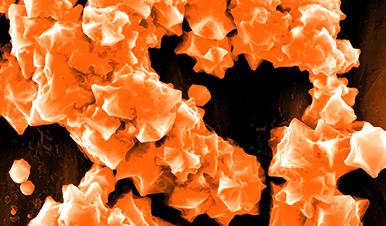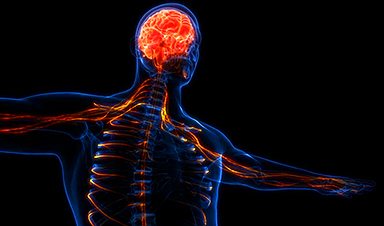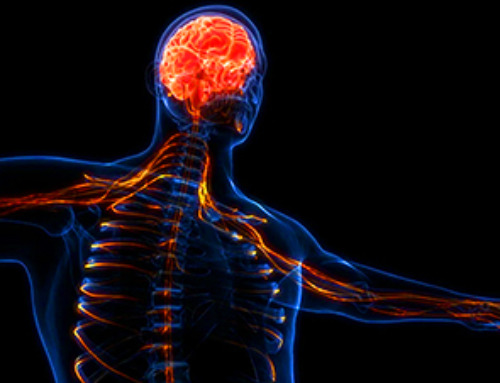Fabrication of materials using data-based techniques is being welcomed as a new strategy that will replace human scientists’ hit and miss tests and labor demanding jobs. In an article published to the chemRxiv* preprint server, a Robotic Scientist framework that may provide unparalleled capabilities for logical design, retrosynthesis, and programmable fabrication of nanoparticles is discussed.
The Robotic Scientist framework is taught to fabricate gold nanocrystals by using multidisciplinary domains such as artificial intelligence, automated robotics, and big data.
Data-Driven Fabrication of Materials
Data-guided development of materials is being hailed as a new paradigm for shifting laborious activities and trial-and-error tests away from human researchers and towards robotic scientists or chemical fabrication mechanized systems.
The sophisticated Human-AI-Robot cooperation system is expediting the multidisciplinary breakthrough in the fabrication of materials towards a Robotic Scientist for mechanized creation.
Convergence of chemical research, theoretical modeling, purpose-driven databases, configurable cyber networks, and mechanized physical systems is required in this growing discipline.
One of the potential objectives is digitized material generation, which involves gradually collecting information, efficiently revealing data links, and producing viable solutions over time based on prior iterations.
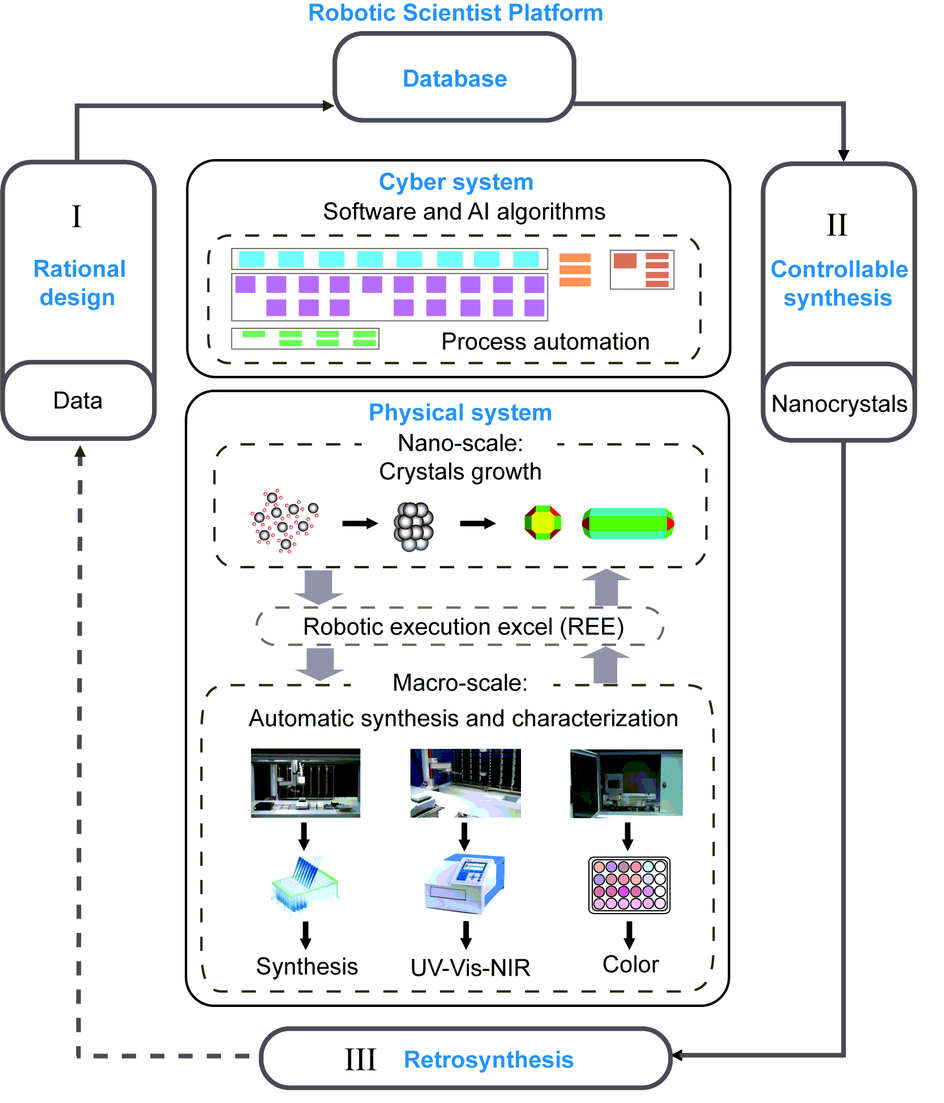
Figure 1. Robotic Scientist platform. Convergence of the database, cyber system, and physical system and process flow: I. Rational design, II. Controllable synthesis, and III. Retrosynthesis for closed-loop synthesis of nanocrystals based on the Robotic Scientist platform. © Zhao, H., Chen, W., et al. (2022)
Existing Work on Automated Fabrication Processes
Significant endeavors have been undertaken in the last decade to achieve digital production of substances.
On the macro-scale, layer-by-layer computerized additive production of 3D substances has been established. Artificial biology is a micro-scale milestone for the computerized fabrication of biomaterials using cells as the hardware on which genes are programmed
Lately, there has been considerable growth in biological programming languages and autonomous systems for chemical synthesis on a small scale. Simultaneously, a computerized chemist has been reported in order to find photocatalysts, opening the door to automated synthetic material research on the micro-scale.
Nonetheless, there are several limits to computerized fabrication, such as material searches lacking conceptual models, blind modification of substances without science-based methodology, and a lack of hardware-software integration to enable material innovations.
As an example, this study illustrates how the Robotic Scientist framework, which allows logical design, controlled fabrication, and retrosynthesis of nanocrystals, may address these challenges.
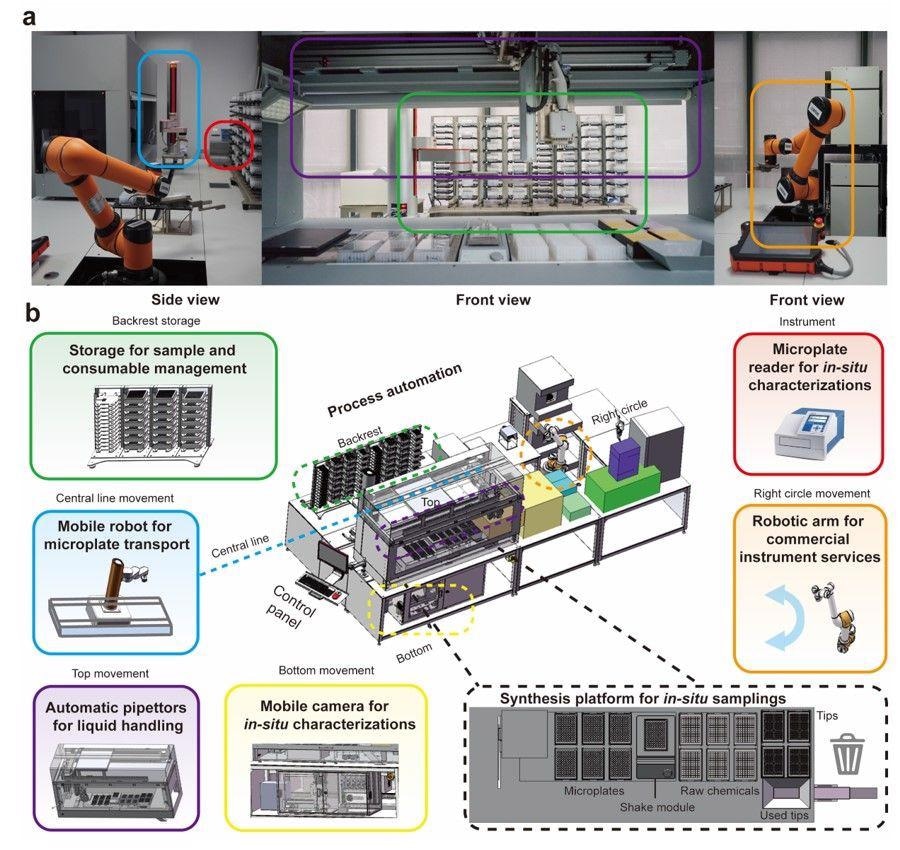
Figure 2. Illustration of the Robotic Scientist platform. a, Photograph. b, Schematic representation. The color frames in the photograph and schematic representation match each other. Backrest: Storage for the sample, microplates and pipette tips; Central line: Mobile robot for microplate transport; Top: Three automatic pipettors for liquid handling; Bottom: Mobile color-ultra-sensitive camera for in situ color characterization; Platform: Synthesis platform for in situ sampling; Instrument: Microplate reader for in situ UV-Vis-NIR absorption spectrophometry; Right circle: Robotic arm for instrument services. © Zhao, H., Chen, W., et al. (2022)
Advantages of the Proposed Robotic Scientist
Educating scientists with the necessary expertise requires significant resources, and alternative biochemical and material synthesizing processes might result in a wide range of results, even for qualified professionals.
Furthermore, the majority of artificial synthesis is trial-and-error and arduous, with inevitable inadvertent errors.
The Robotic Scientist framework reported is a significant development in automation relevant to nanocrystal production and represents an important leap towards data-guided materials development.
The merging of Robotic Scientist-aided production on the macro level and nanocrystal development on the nanoscale results in a complex tight loop comprising logical design, controlled fabrication, and retrosynthesis.
Here, existing chemical information based on data analytics, thermodynamics and kinetic models, and machine learning models were coupled to speed logical design of nanocrystal structure given initial assumptions.
To prevent unguided tuning of materials, orthogonal tests, as well as one, two, and three-factor experimentations, were carried out in cycles, and a database was built for successful training of the machine learning models to allow controlling the fabrication of nanoscale crystals.
The readily available large data set (on-site categorized UV-Vis-NIR absorption spectra and RGB color results) and smaller data set (ex-situ TEM validation) were produced in these procedures to ascertain the Au nanocrystals genome, and genome understanding plays a critical role in assisting the retrosynthesis operation.
The researchers proved that the Robotic Scientist can be taught in the same way as a human scientist can for retrosynthesis and scalable fabrication of the desired gold nanocrystals.
Using the Robotic Scientist platform, this effort centers on developing a closed-loop (design-synthesis-retrosynthesis) of automation in nanoscale crystal fabrication.
Even though a full Robotic Scientist was an idealistic goal, the developed model is a solid stepping stone toward a Robotic Scientist with the key abilities of scientific hypotheses, tests by combining hardware and computer components, and result interpretation.
Future initiatives are expected to narrow the gap, with ultimate automation of all phases of nanocrystal production.
Although the Robotic Scientist was only shown for gold nanocrystals in this study, the findings show that automation has the potential to expedite data-driven materials discovery on the nanoscale.
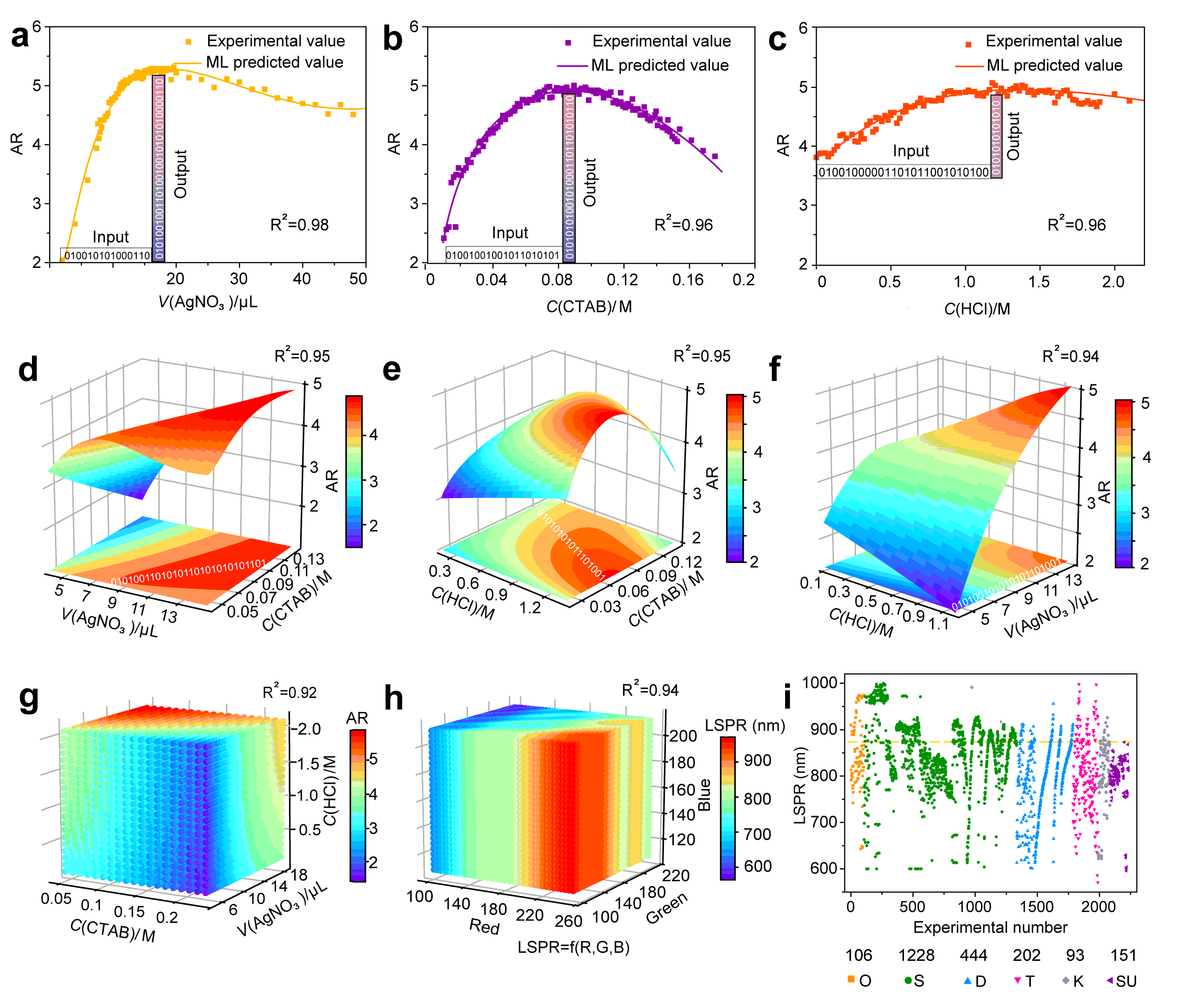
Figure 3. Controllable synthesis, ML prediction, and database construction. a–c, Single-factor ML predicted models. d–f, Double-factor ML predicted models. g, Triple-factor ML predicted models. h, LSPR-color model. i, Overview of the number of experiments: O, S, D, T, K, and SU represent the orthogonal, single-, double-, triple-factor, kinetics, and scale-up experiments, respectively. The relationship between the experimental factors (as inputs) and AR (as outputs) is identified, and ‘01010101’ is the schematic diagram of the controllable range. © Zhao, H., Chen, W., et al. (2022)
*Important Notice
ChemRxiv publishes preliminary scientific reports that are not peer-reviewed and, therefore, should not be regarded as conclusive or treated as established information.
News
Nerve Damage Can Disrupt Immunity Across the Entire Body
A single nerve injury can quietly reshape the immune system across the entire body. Preclinical research from McGill University suggests that nerve injuries may lead to long-lasting changes in the immune system, and these [...]
Fake Science Is Growing Faster Than Legitimate Research, New Study Warns
New research reveals organized networks linking paper mills, intermediaries, and compromised academic journals Organized scientific fraud is becoming increasingly common, ranging from fabricated research to the buying and selling of authorship and citations, according [...]
Scientists Unlock a New Way to Hear the Brain’s Hidden Language
Scientists can finally hear the brain’s quietest messages—unlocking the hidden code behind how neurons think, decide, and remember. Scientists have created a new protein that can capture the incoming chemical signals received by brain [...]
Does being infected or vaccinated first influence COVID-19 immunity?
A new study analyzing the immune response to COVID-19 in a Catalan cohort of health workers sheds light on an important question: does it matter whether a person was first infected or first vaccinated? [...]
We May Never Know if AI Is Conscious, Says Cambridge Philosopher
As claims about conscious AI grow louder, a Cambridge philosopher argues that we lack the evidence to know whether machines can truly be conscious, let alone morally significant. A philosopher at the University of [...]
AI Helped Scientists Stop a Virus With One Tiny Change
Using AI, researchers identified one tiny molecular interaction that viruses need to infect cells. Disrupting it stopped the virus before infection could begin. Washington State University scientists have uncovered a method to interfere with a key [...]
Deadly Hospital Fungus May Finally Have a Weakness
A deadly, drug-resistant hospital fungus may finally have a weakness—and scientists think they’ve found it. Researchers have identified a genetic process that could open the door to new treatments for a dangerous fungal infection [...]
Fever-Proof Bird Flu Variant Could Fuel the Next Pandemic
Bird flu viruses present a significant risk to humans because they can continue replicating at temperatures higher than a typical fever. Fever is one of the body’s main tools for slowing or stopping viral [...]
What could the future of nanoscience look like?
Society has a lot to thank for nanoscience. From improved health monitoring to reducing the size of electronics, scientists’ ability to delve deeper and better understand chemistry at the nanoscale has opened up numerous [...]
Scientists Melt Cancer’s Hidden “Power Hubs” and Stop Tumor Growth
Researchers discovered that in a rare kidney cancer, RNA builds droplet-like hubs that act as growth control centers inside tumor cells. By engineering a molecular switch to dissolve these hubs, they were able to halt cancer [...]
Platelet-inspired nanoparticles could improve treatment of inflammatory diseases
Scientists have developed platelet-inspired nanoparticles that deliver anti-inflammatory drugs directly to brain-computer interface implants, doubling their effectiveness. Scientists have found a way to improve the performance of brain-computer interface (BCI) electrodes by delivering anti-inflammatory drugs directly [...]
After 150 years, a new chapter in cancer therapy is finally beginning
For decades, researchers have been looking for ways to destroy cancer cells in a targeted manner without further weakening the body. But for many patients whose immune system is severely impaired by chemotherapy or radiation, [...]
Older chemical libraries show promise for fighting resistant strains of COVID-19 virus
SARS‑CoV‑2, the virus that causes COVID-19, continues to mutate, with some newer strains becoming less responsive to current antiviral treatments like Paxlovid. Now, University of California San Diego scientists and an international team of [...]
Lower doses of immunotherapy for skin cancer give better results, study suggests
According to a new study, lower doses of approved immunotherapy for malignant melanoma can give better results against tumors, while reducing side effects. This is reported by researchers at Karolinska Institutet in the Journal of the National [...]
Researchers highlight five pathways through which microplastics can harm the brain
Microplastics could be fueling neurodegenerative diseases like Alzheimer's and Parkinson's, with a new study highlighting five ways microplastics can trigger inflammation and damage in the brain. More than 57 million people live with dementia, [...]
Tiny Metal Nanodots Obliterate Cancer Cells While Largely Sparing Healthy Tissue
Scientists have developed tiny metal-oxide particles that push cancer cells past their stress limits while sparing healthy tissue. An international team led by RMIT University has developed tiny particles called nanodots, crafted from a metallic compound, [...]
